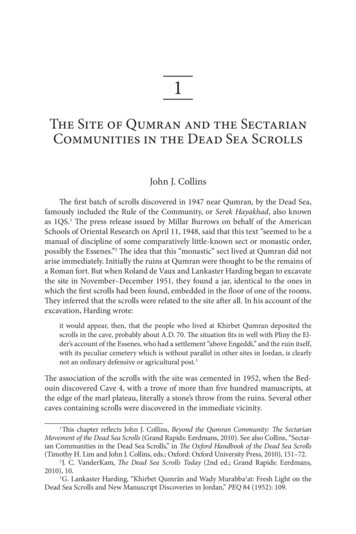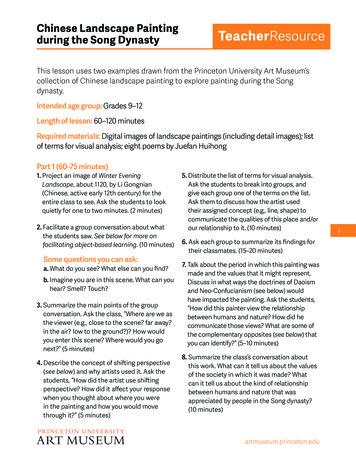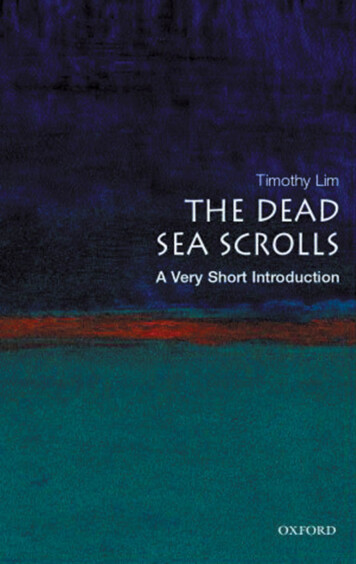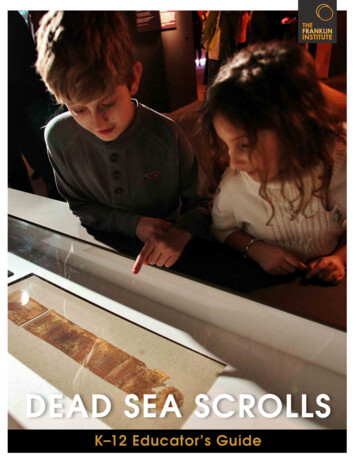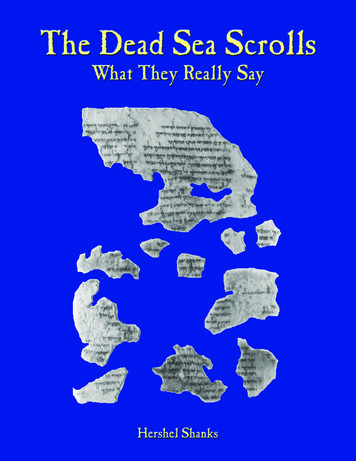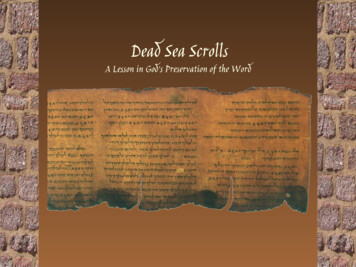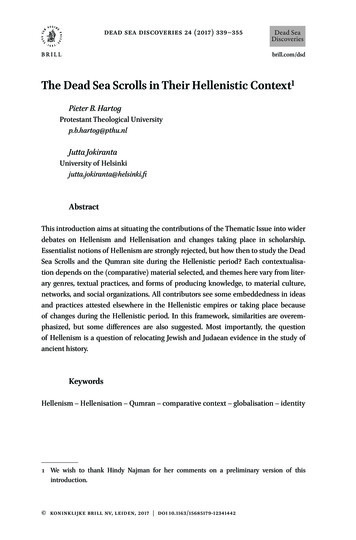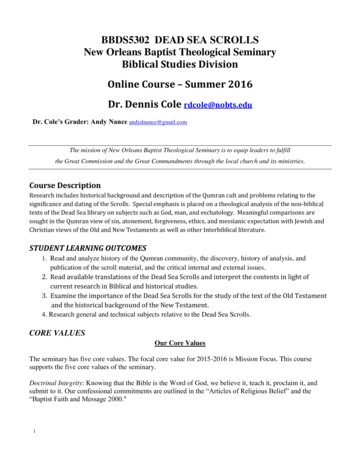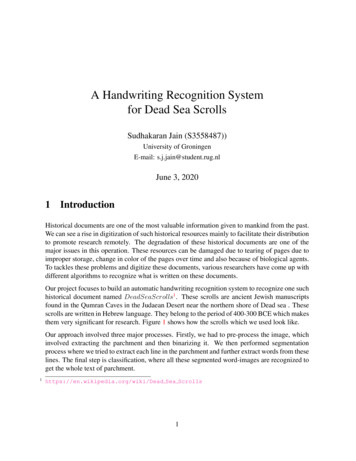
Transcription
Chinese Landscape ScrollsKathleen Fuller – Spring 2009Purpose:The target grade of this Art lesson is middle school students in the 6th grade. Students willcreate a landscape painting in a traditional Chinese style.Students will: Explore and discuss images and writing from Chinese artists, comparing Chineselandscape artwork to Western art Paint their own landscape painting using similar Chinese techniques Embellish their artwork with a personal sealEssential Questions: What are some elements found in a landscape painting? Could they be consideredsymbolic?What are some of the Taoist beliefs?How are these beliefs depicted in Chinese landscape paintings?In what ways do Chinese and Western landscape paintings differ?Materials: Descriptive text on Mountains ofthe Immortals and The Fanghu Isleof the ImmortalsPictures of various landscapes andgardensWhite construction/watercolorpaper (8.5"x 11")One long piece of white paper atleast 8.5" wide, such as shelf paperBlack inkBlack, red, and gold tempera paintand brushes Pencils and erasersPlastic cups to hold waterMixing traysGluewooden dowelsString/ribbonPotatoes, cut in halfX-Acto knivesConstruction paper (12"x 18")ScissorsPowerPoint presentation of imagesand informationLesson Introduction:Ask students to define the word "landscape," considering how natural elementscontribute to that definition.The Chinese word for landscape is shanshui (pronounced "shan shway"), meaning"mountain and water." Read the information on Mountains of the Immortals and TheFanghu Isle of the Immortals and have students identify these elements of a Chinese
landscape: mountains, trees, waterfalls, clouds, a Taoist temple, immortals, and acrane. As you locate these details, discuss their possible symbolic significance.Ask students to determine whether these scenes are taking place in an imagined oractual location.Discuss and review Taoist beliefs based on learning from 6th grade Social Studiescurriculum.Compare the two images to Western art by discussing their composition, perspective,colors, material, and format.For example: Western paintings, like photographs, tend to present images oflandscapes from a fixed point of view with a mathematically constructed illusion ofrecession, or perspective, which makes space appear to recede toward a single"vanishing point." Chinese landscape paintings use a moving perspective based onthe notion of three distances (near, middle, and far – students should know this asforeground, middle ground and background) which allows the eye to move betweenvarious pictorial elements without being limited to one fixed, static point of view.Thus, the viewer is encouraged to ramble through the landscape image.Activity:Part 1 – Landscape Painting Ask students to choose one of the above paintings and make a list of its details.Encourage them to imagine entering the landscape, thinking about the followingquestions: What natural and man-made things do you see? What would you like to explore? How does it feel to be standing under the soaring peaks? What sounds, smells, and textures surround you? Is anyone else with you in the landscape? Then students will paint a landscape on a horizontal piece of whiteconstruction/watercolor paper. Start with gold paint diluted in water as a wash. Whileit dries, students can create three different gradations of gray using the black ink.With the black and grays, they can add the details of the landscape.Part 2 – Creating a Seal or Chop In East Asian art, a person's signature is often stamped with a personal seal.Students can make their own seal with a potato. Students may want to researchChinese characters for their seal. Their design will represent their signature on theirscroll. Students will sketch ideas for their seal or use the sketch or symbol theycreated in social studies class. Explain that sketches should be kept simple as theywill be carving in a very small space.
1. The design the student decides to use needs to be drawn, in reverse, on thesurface of the potato. First draw the design on tracing paper then turn the paperover to see its reversed image.2. The design is carefully cut out of the potato with a plastic knife. Cutting alongeach side of the line to be removed at a slight angle, creating a v-shaped cut.3. When the students are ready, tell them to press the seal into red tempera paintand try printing it on a scrap of paper. If a clear impression does not result moremay need to be cut away. Then, have students stamp it onto their paintings.Part 3 – Creating the Class Handscroll Collect all of the landscapes and attach them to a long piece of paper. (or makeseveral smaller ones with 5-6 landscapes)Leave five inches on either end of the paper for the wooden dowels. Sincehandscrolls are read from right to left, roll the scroll around the left dowel. Attach apiece of string to the right side of the long piece of paper.Place the rolled handscroll on a long table; as small groups of students unroll it, viewthe immense landscape. Hang it up in the classroom across a long wall.Evaluation: Group critiqueArt project rubricAdaptation:This lesson can be adapted for higher grade levels by having students write a poembased on interpretation of Chinese landscape paintings to be included on the scroll,creating individual hand scrolls and/or using gum erasers to create their seal so it can beused over again.Lower grade levels based on time, either can eliminate Part 2 of the activity, or can havea few choices of Chinese characters to create their personal seal. In addition, simplelandscape templates for these students may need to be created to trace or use as areference while they are painting.Standards: Compare and contrast visual forms of expression found throughout different regionsand cultures of the world. Analyze and demonstrate the stylistic characteristics of culturally representativeartworks. Recognize and demonstrate the qualities and characteristics of craftsmanship inoriginal works of art. Interpret selected works of art based on visual clues in the works. Compare the ways that selected ideas and concepts are communicated through theperspective of visual art and through the perspectives of other academic disciplines.
Mountains of the ImmortalsThe style of this handscroll intentionally imitates much earlier landscape paintings of the Northernand Southern-dynasties period. When China was under the control of the foreign Mongol government,this style represented communion with a distinctively Chinese cultural heritage. The reference to anolder painting style is strengthened by the use of bright mineral pigments to color the mountains. Thishighlights the conception of the mountain as the material form of vital energy, the same concept thatallowed the minerals found in mountains to be used as ingredients in elixirs of alchemy.Chen Ruyan's work is a classic depiction of an immortals' paradise. The visual journey through thepainting begins with the Taoist temple nestled in the mountains at the right of the scroll. Further on,an immortal sits in a clearing next to a zither and magical fungi and watches a young attendant dancewith cranes, symbols of longevity. In another clearing to the left, two more immortals walk amongauspicious animals and plants, while a third immortal rides above them on a crane.Chen Ruyan was an associate of several famous Yuan-dynasty landscape painters known for theirconnections with Taoism, including Ni Zan (1306 1374), who inscribed this painting. Chen aided inthe downfall of the Yuan government and served the new Ming dynasty until he was executed for anunknown offense in 1371. At the beginning of the Ming dynasty, this was already his most famouswork.The Fanghu Isle of the ImmortalsFanghu (literally, "square jar") is one of three mythical island homes of immortals traditionally thoughtto lie in the sea off the east coast of China. Fanghu was a common theme in Chinese painting, and thishanging scroll depicting it is one of the finest. Belief in this island dates to at least the third centuryB.C., when the first emperor of China sent an expedition into the eastern sea in the hopes of makingcontact with beings who could teach him the secrets of immortality. This expedition remains one ofthe more tragic events in Chinese history: since immortals were believed to have eternal youth, theemperor sent an embassy of young boys and girls to communicate with them. None returned. Largelybecause of this event, Taoists came to believe that Fanghu and the other islands either lay beyondviolent seas that prevented mortals from finding them or rested on the backs of great tortoises whowere constantly in motion, so that the mountains had no permanent location.Wang Yun depicted the mythical Fanghu rising from such an ocean. In this scroll, a precariouslyperched, oddly-shaped rock formation rises forcefully from surging waves. The other islands can beseen in the background through mist. The island is inhabited by immortals, whose red-and-greenpalaces with gold roofs resemble Taoist temples nestled in the folds of the rock. The rest of themountain is an ideal landscape adorned with magical plants and trees, misty vapors, and mysteriouscaverns from which waterfalls descend. The inscription in the upper left by the artist indicates that thishanging scroll was painted for a Taoist named Helao and based on an older Song-dynastycomposition.
Wang Yun (1652 1735 or later)The Fanghu Isle of the Immortals (detail)Qing dynasty, Kangxi reign, dated 1699Hanging scroll; ink and colors on silk142 x 60.3 cmChen Ruyan(c. 1331 1371) Mountains of the Immortals (detail)Yuan dynasty, late 14th centuryHandscroll; ink and colors on silk33 x 102.9 cm
The Chinese character SHAN: mountain/sThe Chinese character SHUI (pronounced "shway"): water, river/s, stream/s
Chinese Landscape Scrolls Kathleen Fuller - Spring 2009 Purpose: The target grade of this Art lesson is middle school students in the 6 th grade. Students will create a landscape painting in a traditional Chinese style. Students will: Explore and discuss images and writing from Chinese artists, comparing Chinese landscape artwork to Western art

